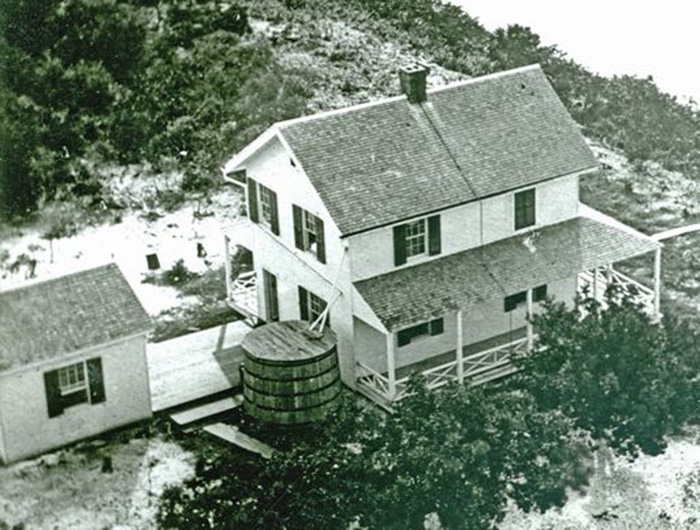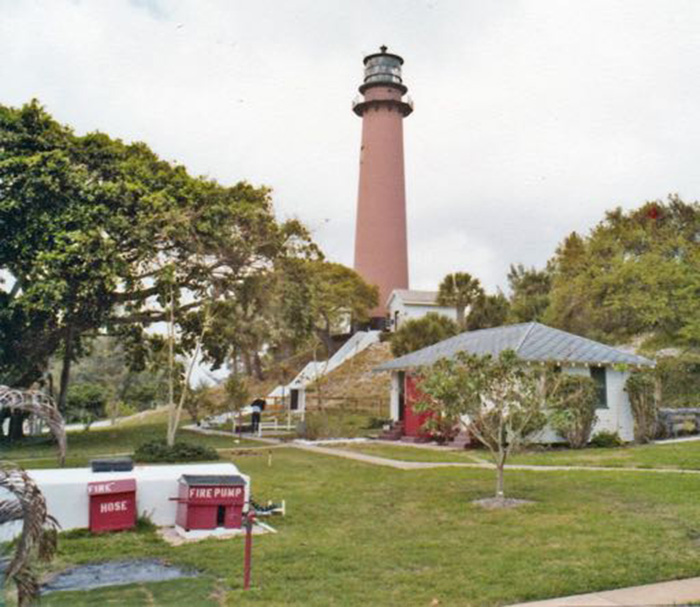The Ingenious Water Solutions of the Jupiter Inlet Lighthouse Keepers
![]() 5 min read
5 min read
The Jupiter Inlet Lighthouse, standing proudly in northern Palm Beach County, has long been a beacon of history and culture. One of the lesser-known yet crucial aspects of its history is the ingenious ways early lighthouse keepers secured the lighthouse fresh water supply. On July 13, 2024, the Jupiter Inlet Lighthouse & Museum will host its inaugural Loxahatchee River Heritage Day, an event celebrating the rich history and natural beauty of the Loxahatchee River region. As we prepare for this event, let’s dive into a fascinating aspect of the lighthouse’s history: how its early keepers secured fresh water in an environment where natural supplies were scarce and often unreliable.

This photo of the Jupiter Wireless Telegraph Station, Jupiter Inlet Light Station, and Jupiter Weather Bureau Station shows the windmills used to pump water for all three government facilities, circa 1910. (LRHS Carlin Collection)
How Did Early Lighthouse Keepers Survive?
Imagine being an early lighthouse keeper at the Jupiter Inlet Lighthouse. Your duties involved maintaining the light, ensuring it guided ships safely through the treacherous waters. But beyond these responsibilities, you also faced the critical challenge of securing the lighthouse fresh water supply for daily needs— a difficult task in a region where the nearby Loxahatchee River provided brackish and undrinkable water.
In those days, the river’s proximity to the inlet meant its water was a mix of salt and fresh, fluctuating with the tides and rainfall. During dry spells, the river could become stagnant, making it even less suitable for consumption. To overcome this, lighthouse keepers had to rely on a combination of cisterns and wells—innovative solutions that ensured their survival.
What Is a Cistern?
A cistern is a storage container used to collect and store rainwater. For the Jupiter Inlet Lighthouse keepers, cisterns were a lifeline. These structures collected rainwater from the roofs of the keepers’ dwellings, channeling it through gutters into large, often in-ground storage tanks. This method was essential for providing fresh water in an area where natural sources were unreliable, ensuring a steady lighthouse fresh water supply.
At the Jupiter Inlet Lighthouse, the 1860 keepers’ dwelling featured a brick cistern located under its northeast corner. Although the house was destroyed by fire in 1927, an archaeological dig in 2010 uncovered the cistern, revealing that it was still functional at collecting water. Today, visitors to the lighthouse can see this historic cistern preserved under Plexiglas at the east end of the deck, beneath a large ficus tree. This tangible piece of history offers a glimpse into the resourcefulness of the early keepers.

A 2010 archaeological dig uncovered the original keeper’s dwelling cistern, full of debris from the destroyed house.
The Role of Cisterns and Wells
The ingenuity didn’t stop with cisterns. In 1883, a separate house was built for the head keeper, complete with its own cistern under the breezeway leading to the kitchen. This cistern continued to serve the Coast Guard for fire safety until the 1980s, long after the house was demolished in 1959. During recent renovations, the remnants of this cistern were uncovered and preserved, showcasing the enduring legacy of these early water management systems.

The 1883 Head Keeper’s Dwelling viewed from the Lighthouse. The in-ground cistern was located under the wooden breezeway connecting the
house and kitchen. The roof gutters can be seen leading into the large barrel cistern that provided additional water storage.

Jupiter Inlet Lighthouse in 1977. The cistern is in the left foreground. The large ficus tree is on the left and the Keepers’ workshop is on the right. (Coast Guard Historian’s Office)
Cisterns were not only used for drinking and cooking but also for emergency firefighting. Accidents involving wood stoves and kerosene lamps, as well as brush fires from the surrounding sand pine scrub, posed significant risks. However, cisterns had their drawbacks. They could be contaminated by salt spray, bird droppings, and debris from the roof. To mitigate this, keepers often disconnected the gutters from the cisterns during the first rainfall after a dry spell to wash off the roof.
Wells: A Reliable Source of Fresh Water
While many lighthouses lacked access to fresh groundwater, the Jupiter Inlet Lighthouse was fortunate to have a well. The well is believed to be part of the original construction in 1859-1860, and it would have provided the first lighthouse keepers with a reliable water source. Although there is no documentation to confirm the date on which it was built, the first written mention of this well comes in the late 1870s, when visitors praised its excellent water quality. Initially, the water was drawn by hand, but in 1906, a windmill was installed to automate the process. Further modernization came in 1918 with the construction of a gasoline-powered jack pump and a 30-foot steel tower topped with a 4,500-gallon cypress water tank.
This advanced system remained in use until the late 1950s when contamination issues led to the well’s discontinuation. The water tank was removed during the 1959-1960 Coast Guard renovations, marking the end of an era in the lighthouse’s water management history.
Modern Amenities and Historical Preservation
Life at the lighthouse improved significantly in the early 20th century with the introduction of modern amenities. Bathtubs were installed in 1907, and indoor toilets followed in 1916, replacing the outhouses that had been used for decades.

Closeup of the well exterior under the Keepers’ Workshop in 2010. Visitors today can see the well through Plexiglas in the floor.
The Weather Bureau Station and Naval Radio Station, which shared the lighthouse reservation, were similarly equipped. Both initially relied on windmill-driven wells and had their own water towers and cisterns. The Navy’s cistern, unlike those at the lighthouse, was an in-ground brick structure with a wooden top, located behind the main operations building.
During the 1959-1960 renovations, a new pumphouse was constructed to supply water to the keeper dwellings, and each of the nine Coast Guard houses built in 1962 had its own well and septic tank. This modernization ensured a reliable water supply and improved sanitary conditions for the lighthouse keepers.


The cistern at Naval Radio Station Jupiter in 1917 and the remnants found after the recent asphalt removal.
A Legacy of Ingenuity and Resilience
The history of water management at the Jupiter Inlet Lighthouse is a testament to the ingenuity and resilience of its keepers. From cisterns collecting rainwater to wells providing fresh groundwater, these methods ensured the survival and operation of the lighthouse. As we celebrate Loxahatchee River Heritage Day, we honor these historical practices and the keepers who implemented them.
Join us on July 13th to explore this and other fascinating aspects of the Jupiter Inlet Lighthouse’s history. Engage with living history presentations, enjoy guided tours, and meet local history authors and experts. Discover the stories that shaped our community and appreciate the innovations that sustained it through the years.
